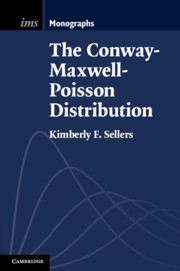Book contents
- Frontmatter
- Dedication
- Contents
- Figures
- Tables
- Preface
- Acknowledgments
- 1 Introduction: Count Data Containing Dispersion
- 2 The Conway–Maxwell–Poisson (COM–Poisson) Distribution
- 3 Distributional Extensions and Generalities
- 4 Multivariate Forms of the COM–Poisson Distribution
- 5 COM–Poisson Regression
- 6 COM–Poisson Control Charts
- 7 COM–Poisson Models for Serially Dependent Count Data
- 8 COM–Poisson Cure Rate Models
- References
- Index
5 - COM–Poisson Regression
Published online by Cambridge University Press: 02 March 2023
- Frontmatter
- Dedication
- Contents
- Figures
- Tables
- Preface
- Acknowledgments
- 1 Introduction: Count Data Containing Dispersion
- 2 The Conway–Maxwell–Poisson (COM–Poisson) Distribution
- 3 Distributional Extensions and Generalities
- 4 Multivariate Forms of the COM–Poisson Distribution
- 5 COM–Poisson Regression
- 6 COM–Poisson Control Charts
- 7 COM–Poisson Models for Serially Dependent Count Data
- 8 COM–Poisson Cure Rate Models
- References
- Index
Summary
This chapter introduces the Conway–Maxwell–Poisson regression model, along with adaptations of the model to account for zero-inflation, censoring, and data clustering. Section 5.1 motivates the consideration and development of the various COM–Poisson regressions. Section 5.2 introduces the regression model and discusses related issues including parameter estimation, hypothesis testing, and statistical computing in R. Section 5.3 advances that work to address excess zeroes, while Section 5.4 describes COM–Poisson models that incorporate repeated measures and longitudinal studies. Section 5.5 focuses attention on the R statistical packages and functionality associated with regression analysis that accommodates excess zeros and/or clustered data as described in the two previous sections. Section 5.6 considers a general additive model based on COM–Poisson. Finally, Section 5.7 informs readers of other statistical computing softwares that are also available to conduct COM–Poisson regression, discussing their associated functionality. The chapter concludes with discussion.
Keywords
- Type
- Chapter
- Information
- The Conway–Maxwell–Poisson Distribution , pp. 153 - 217Publisher: Cambridge University PressPrint publication year: 2023

